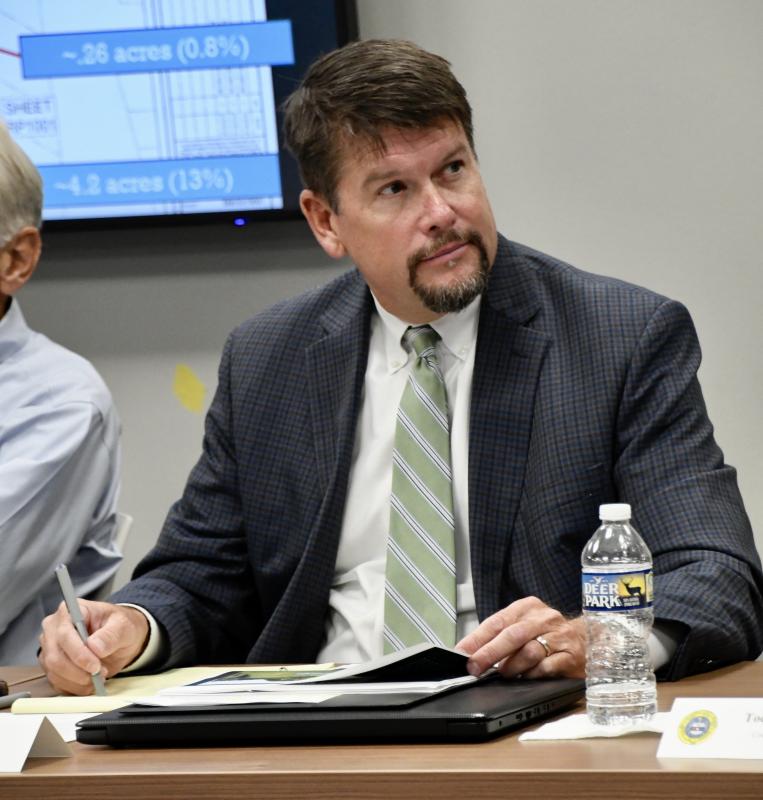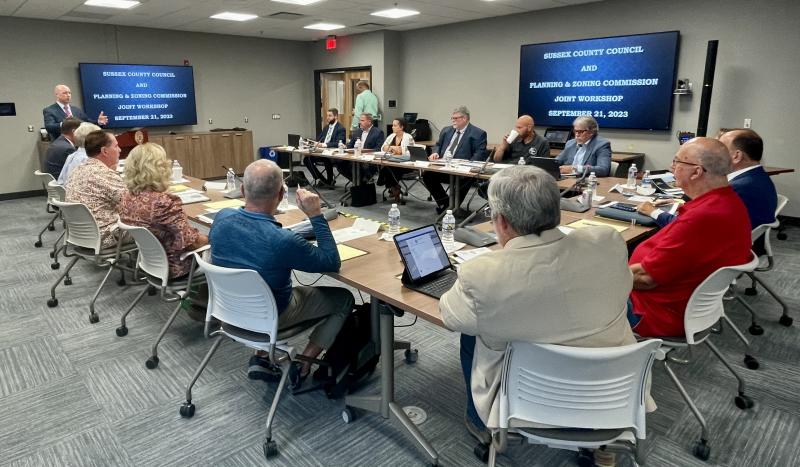Sussex officials prepare to tackle land-use issues
Members of Sussex County Council and the Sussex County Planning & Zoning Commission attended a workshop Sept. 21 to review land-use policies in county code – most related to subdivision development – for possible changes.
The workshop included discussions and information on perimeter buffers, forest preservation, open space, code updates, accessory buildings and single- and double-wide manufactured homes, managed meadows and interconnectivity between parcels.
“This is step one of many steps,” said County Administrator Todd Lawson, who served a presenter.
Most of the discussion centered around forest preservation and perimeter buffers, which are two hot-button issues among residents and grassroots groups.
Council and commissioners are sure to discuss the issues further in future meetings and possibly draft new or amended ordinances.
No public testimony was accepted during the workshop, which included a 95-page Powerpoint presentation over three hours.
The two public access rooms at the county's new emergency operations center were filled before the workshop started. Among those attending was a large contingent of members of the Builders and Remodelers Association of Delaware, wearing stickers with “Homes=Jobs” and “I support property rights” on them.
Prior to the workshop, President Mike Riemann said the money the construction industry generates in the Sussex economy and the thousands of jobs it creates should not be stifled by regulations.
Perimeter buffers
Lawson said some of the conditions in existing code are problematic. Currently, existing woods can be cut along perimeters to make way for development. He said site-work regulations are vague and not followed.
Assistant county attorney Vince Robertson added that cluster and standard subdivisions have separate regulations. “We need this all in one plan that applies to everything,” he said.
In addition, Lawson said native plants and trees are not listed in code, and inspection of perimeters historically has been limited.
The code contains specifics on the size of trees and evergreens planted, Vincent said.
However, Lawson showed several examples of new subdivisions with buffers planted that do not follow code.
The timing of when perimeter buffers are added can also be problematic, Lawson added.
“Some buffers are not put in for years and done by phases. Is this a loophole?” asked Councilman Mark Schaeffer.
Councilman John Rieley said regulations must require that mature trees in buffers cannot be removed.
He said the net effect could be wider buffers. “Now, bulldozers are running over roots, killing trees. Mature trees are more effective than small saplings,” he said.
“We need to preserve existing buffers and the growth in them. Silt fencing should be in before any construction and should be outside the drip line of existing trees,” Schaeffer said.
County engineer Hans Medlarz said there are no access requirements for perimeter buffers to allow access for maintenance.
“We need one standard for all residential development,” Lawson said. “Is 30 feet wide enough? There also has to be some design flexibility.”
Vincent said enforcement could include holding back building permits.
“The county can do better with inspections, and we are committed to doing that,” Lawson said.
There also need to be penalties for those who pre-cut buffers before development, said Commissioner Bruce Mears.
“Cutting trees in the existing forest line can lead to damage to other trees,” Medlarz said, adding woodlands preservation is a balancing act.
Forest preservation
Lawson said there are limited rules related to forest preservation and restoration in county code.
County Planning & Zoning Director Jamie Whitehouse said there is nothing in code to prohibit clear-cutting.
Councilman Doug Hudson said if forests are clear-cut prior to an application, the wait should be five or 10 years before development can occur.
“Let’s put some teeth in it,” he said.
Rieley said regulations are generic and vague.
“How do we tighten the language up? Perhaps we need to reconsider the yield plan for superior design,” he said.
Under a previous ordinance, an applicant was required to submit a yield plan showing the maximum number of dwelling units possible under a standard subdivision with 20,000-square-foot lots. The number of lots in the cluster subdivision design couldn't exceed the number of lots in the yield plan. It was stricken from the ordinance.
Schaeffer suggested an incentive of increased density granted to developers who preserve old-growth forest and woodlands.
“This should be strongly considered,” he said.
Lawson said the cluster option was enacted to save trees, with 7,500-square-foot lots compared to 10,000-square-foot lots in standard subdivisions. He said larger lots tend to lead to more tree clearing.
“But is 7,500 square feet the right number?” he asked.
Forestry questions
“Work done near woods can damage root mass,” said state forester Chris Miller.
“Is there a benefit to select cutting in a buffer?” Rieley asked.
“It has to be done early enough, because there is a high mortality rate of trees along the edge of a property,” Miller responded.
Miller said one of the missions of the Delaware Forest Service is to issue permits for all logging activities. He said the permits are for loggers and sometimes property owners.
“But developers were coming in getting logging permits unknown to us. We have stopped that until they have a notice-to-proceed letter [from the county],” Miller said.
Drainage issues
Part of the issue involves clearing trees to drain a property to meet Department of Natural Resources and Environmental Control standards, Lawson added.
Medlarz said state regulations are restrictive when it comes to stormwater conveyance.
“It’s easier to clear-cut and start with a clean slate, and the state is driving this,” Rieley said.
“It’s a case-by-case basis. Challenges for each site plan are unique. Drainage is a very important balancing act. It’s a discussion we have to have with DNREC,” said Jessica Watson, Sussex Conservation District program manager.
“We are trying to keep trees and not flood our neighbors,” Rieley added. “What can we do now to preserve as much forest as possible?”
“If you want it, we should change DNREC regulations,” Medlarz answered. “Not every site has the same topography. We need more custom-tailered regulations, because one size does not fit all.”
“It’s a very complex issue that will need feedback and support, and will take some real focus and effort,” Lawson said.
Coalition: Advocacy mattered
Sussex Preservation Coalition President Jane Gruenebaum said the workshop addressed many of the design and land-use issues of concern to residents.
In an email to coalition membership, she wrote: “Your advocacy mattered. The many meetings and emails, the letters to the editor and the public commentary clearly made a difference. During the workshop, the observations, questions and suggestions we witnessed reflected the work of the groups and individuals that are part of coalition.
“Of course, this step was only the first in what could be a long process to get the needed ordinances, codes and enforcements enacted. The coalition will continue to educate about ways to improve land-use regulations and protections, and to support consistent, persistent advocacy.”
Vice President Jill Hicks attended the Sept. 26 council meeting and thanked the council for conducting the workshop.
To see the presentation, go to https://tinyurl.com/28s2bdcu.
Part 2: Open space, housing issues, managed meadows and interconnectivity.























































